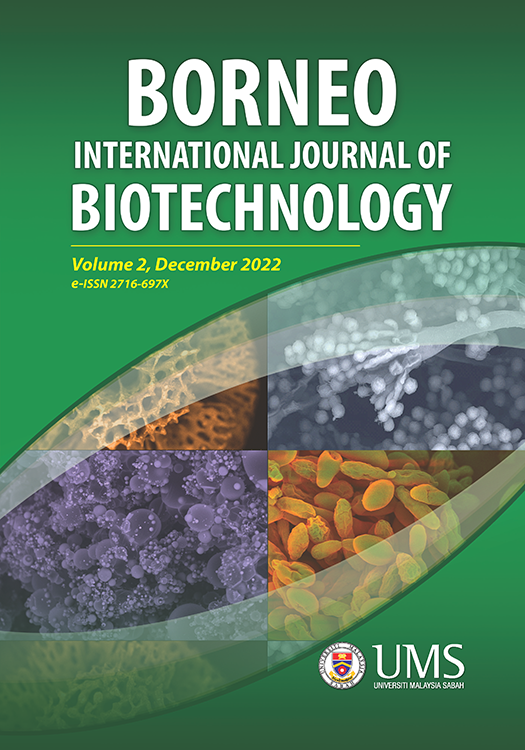Nutritional profiling reveals the effects of dietary zeolite on Asian seabass Lates calcarifer
DOI:
https://doi.org/10.51200/bijb.v2i.4187Keywords:
dietary zeolite, Lates calcarifer, growth performance, immune responseAbstract
As costs for nutrition in aquaculture farming escalate, using affordable feeds that provide an optimal combination of nutrients for the fish species of choice is paramount. Natural zeolites have been applied in aquaculture as early as 1977 including feeds in animal nutrition, and moisture and ammonia control of animal manure. In this study, five experimental diets: control, Z1, Z2, Z4 and Z8 containing 0, 1, 2, 4 and 8% of dietary zeolite respectively were investigated for growth performance and immune responses in Lates calcarifer. In general, dietary zeolite supplementation boosted overall growth performance, particularly with Z4 of 4% zeolite supplementation showing the highest Body Weight Gain (BWG) over the other diets. Feed Conversion Ratios (FCR) and Protein Efficiency Ratio (PER) of fish were found to be significantly improved (P < 0.05) by the supplementation of zeolite. Furthermore, no significant changes in the immune and stress responses of fish at both 4% and 8% zeolite supplementation were exhibited, indicating that the presence of zeolites did not impair the immune state of L. calcarifer. This study suggests the suitability of dietary zeolite supplementation and recommends 4% zeolite supplementation to be the most ideal for improved growth performance for L. calcarifer.
References
Ali, S. S. R., Ambasankar, K., Nandakumar, S., Praveena, P. E., & Syamadayal, J. (2016). Effect of dietary prebiotic inulin on growth, body composition and gut microbiota of Asian seabass (Lates calcarifer). Animal Feed Science and Technology, 217, 87 – 94. https://doi.
org/10.1016/j.anifeedsci.2016.04.011
Boonyaratpalin, M., Suraneiranat, P., & Tunpibal, T. (1998). Replacement of fish meal with various types of soybean products in diets for the Asian seabass, Lates calcarifer. Aquaculture, 161 (1 – 4), 67 – 78. https://doi.org/10.1016/S0044-8486(97)00257-3
Cunniff, P., & AOAC International. (1997). Official methods of analysis of AOAC International (Vol. 16, 3rd Ed.). AOAC International.
Delves, P. J., Martin, S. J., Burton, D. R., & Roitt, I. M. (2016). Roitt’s essential immunology (13th Ed.). Wiley-Blackwell.
FAO. (2016). FAO yearbook of fishery and aquaculture statistics. http://www.fao.org/3/a-i5716t.pdf
Ghiasi, F., & Jasour, M. S. (2012). The effects of natural zeolite (Clinoptilolte) on water quality, growth performance and nutritional parameters of freshwater aquarium fish, angel (Pterophyllum scalare). International Journal of Fish Aquatic Studies, 2 (3), 22 – 25.
Glencross, B., Blyth, D., Irvin, S., Bourne, N., Campet, M., Boisot, P., & Wade, N. M. (2016). An evaluation of the complete replacement of both fishmeal and fish oil in diets for juvenile Asian seabass, Lates calcarifer. Aquaculture, 451, 298 – 309. https://doi.org/10.1016/j.aquaculture.2015.09.01
Irvin, S., Blyth, D., Bourne, N., & Glencross, B. (2016). A study of the discrete and interactive effects of different polysaccharides on the digestibility of diets fed to barramundi (Lates calcarifer). Aquaculture Nutrition, 22 (5), 1047 – 1054. https://doi.org/10.1111/anu.12321
Kanyılmaz, M., Tekelioğlu, N., Sevgili, H., Uysal, R., & Aksoy, A. (2015). Effects of dietary zeolite (clinoptilolite) levels on growth performance, feed utilization and waste excretions by gilthead sea bream juveniles (Sparus aurata). Animal Feed Science and Technology, 200, 66 – 75. https://doi.org/10.1016/j.anifeedsci.2014.09.023
Khodanazary, A., Boldaji, F., Atar, A., & Dastar, B. (2013). Effects of Dietary zeolite and perlite supplementations on growth and nutrient utilization performance, and some serum variables in common carp, (Cyprinus carpio). Turkish Journal of Fish Aquatic Sciences, 13, 495 – 501. http://doi.org/10.4194/1303-2712-v13_3_12
Mohd Shaharudin, N., Mohd Adnan, A., Kua, B. C., & Nathan, S. (2013). Expression profile of immune-related genes in Lates calcarifer infected by Cryptocaryon irritans. Fish Shellfish Immunology, 34 (3), 762 – 769. https://doi.org/10.1016/j.fsi.2012.11.052
Mumpton, F. A. (1999). La roca magica: Uses of natural zeolites in agriculture and industry. Proceedings of the Natural Academy of Science (PNAS), 96 (7), 3463 – 3470. https://doi.org/10.1073/pnas.96.7.3463
Mumpton, F. A., & Fishman, P. H. (1977). The Application of Natural Zeolites in Animal Science and Aquaculture. Journal of Animal Science, 45 (5), 1188 – 1203. https://doi.org/10.2527/jas1977.4551188x
Obradović, S., Adamović, M., Vukašinović, M., Jovanović, R., & Levic, J. (2006). The application effects of natural zeolite in feed and water on production results of Oncorhynchus mykiss (Walbaum). Roum Biotechnol Lett., 11 (6), 3005 – 3013. https://www.zeocat.es/docs/animalfishfarming.pdf
Segner, H., Wenger, M., Moller, A. M., Kollner, B., & Casanova-Nakayama, A. (2011). Immunotoxic effects of environmental toxicants in fish – how to assess them? Environmental Science Pollution Research International, 19 (7), 2465 – 2476. https://doi.org/10.1007/s11356-012-0978-x
Wattanakul, W., Thongprajukaew, K., Songnui, A., Satjarak, J., & Kanghae, H. (2017). Pre-soaking feed pellet significantly improved feed utilization in Asian seabass (Lates calcarifer). Aquaculture, 471, 106 – 112. http://dx.doi.org/10.1016/j.aquaculture.2017.01.014
Yıldırım, O., Türker, A., & Senel, B. (2009). Effects of natural zeolite (clinoptilolite) levels in fish diet on water quality, growth performance and nutrient utilization of Tilapia (Tilapia zillii) fry. Fresenius Environmental Buletin, 18 (9), 1567 – 1570. https://www.steinkraft-naturerocks.
com/content/Effectsofnaturalzeoliteclinoptilolitelevelsinfishdietonwaterquality growthperformanceandnutrientutilizationofTilapia.pdf






